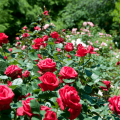Description and characteristics of the Sahara rose, the subtleties of growing
For growing in the garden and as an element of landscape design, the Sahara rose is often used. The plant attracts with its unusual appearance and is appreciated for its high resistance to cold. When growing a Sahara rose, you need to take into account a number of rules and features so that the planting will pleasantly please the eye for a long time.
History of creation
The Sahara rose variety was bred in 1996. The flower petals are distinguished by their unique tints, but the basic colors are yellow and sand. According to one version, it was the presence of a sandy reflection that gave the name in honor of the largest hot desert.
General characteristics and description of the climbing rose Sahara
The main feature of the climbing Sahara variety is the change in color throughout the entire flowering period. The petals take on pale yellow, orange, sandy and crimson hues. Flowers grow to a size of 10 cm in diameter and grow in clusters in collected racemes. The height of the rose is 0.5-1.5 m. The stems are smooth and have no thorns. The leaves are large, rich green.
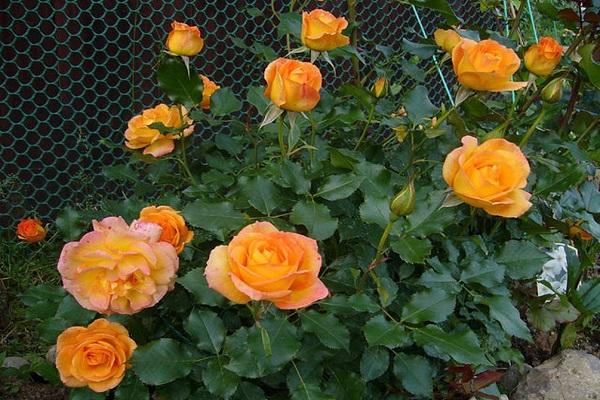
Pros and cons of the variety
Many gardeners choose to grow the Sahara rose due to a number of comparative advantages. Positive characteristics include:
- Frost resistant. Even when exposed to cold, the plant continues to bloom continuously.
- Unpretentious care. Even a novice gardener can cope with the planting, since it does not require a specific approach.
- Unusual appearance. The overflow of shades, the large size of the flowers and a large number of bright buds on the spreading branches make the rose a real decoration of the garden plot.
- Landing variability. Planting looks great in single plantings and in combined groups, which expands the possibilities of use in landscaping.
There are no obvious disadvantages to the variety in question. Proper planting and minimal maintenance will allow you to enjoy the fragrant and beautiful flower throughout the season.

Growing rules
To prevent the plant from withering and taking root well on the site, you must follow the standard growing rules. An important role is played by the selection of a suitable seedling, the allocation of space for planting and the direct transfer of the seedling to the ground for further growth.
Sapling selection
It is better to purchase rose seedlings in specialized nurseries or gardening stores in order to avoid low-quality goods.In addition, upon purchase, you can find out detailed information about the variety.
Saplings can be grafted or self-rooted. Having chosen the grafted option, it is worth clarifying which rootstock the graft was inoculated on, since this affects the resistance to cold.
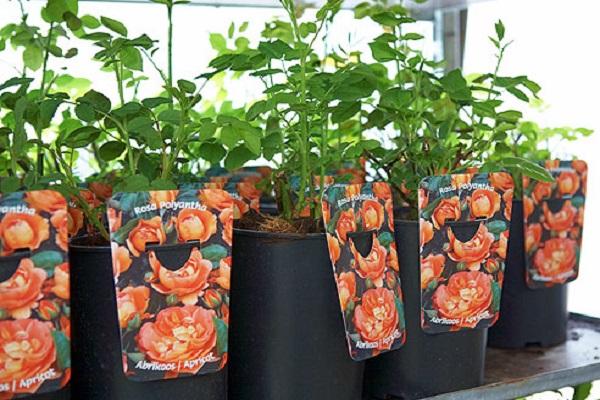
It is recommended to purchase annual plants with closed roots, which already have a sufficiently developed root system. The number of shoots per seedling must be more than three.
When choosing roses with open roots, you should also not worry about possible difficulties, as they will quickly take root in new conditions.
In order for the plantation to develop actively after transfer to the ground, the roots must be in good condition. Healthy seedlings have 2-3 stems from 20 cm in height, live roots, smooth bark, green buds. When buying seedlings in the spring, you need to make sure that the buds are dormant.
Site selection
To plant a rose, a place well-lit by the sun should be allocated. It is advisable to plant the flower in a hilly area with a low groundwater table. It will also help prevent the accumulation of melt water in the spring. Planting next to the southern wall of a house or other large structure prevents the plantings from blowing through.
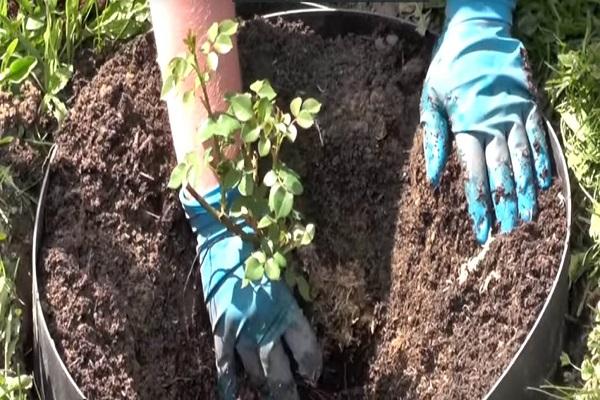
Before planting, the soil on the site is prepared by performing basic agrotechnical techniques. First, the land is cleared of weeds, bushes and various debris. If the soil is dry, then it is diluted with manure, peat, fine sand or humus.
Landing technology
To plant the Sahara roses, they dig a hole 1 m deep. A suitable hole diameter is 0.5 m. Dry leaves and the first top dressing are placed on the bottom, after which the seedlings are placed, sprinkled with soil on the sides. In order for the plant to take root well, immediately after planting it is watered with warm water. It is also recommended to add a little lemon juice to the ground, which stimulates the active growth and development of the plantation.

Flower Care Tips
The key to flower growth is stable and competent care. Performing simple agricultural techniques will not take much time, and the result will be beautiful plants on the site.
Watering
There are several general watering rules that apply to the Sugar variety. These include the following:
- When planting, a small earthen roller is left around the seedling to collect moisture at the roots. The water will not evaporate and spread over the site, but will completely leave the plant.
- The liquid for irrigation is pre-defended. This eliminates a number of harmful components, including chlorine. If possible, water the plants with rainwater.
- Water the bushes with warm water as the soil dries up. It is important to avoid stagnation of the liquid, as this can provoke the formation of rot.
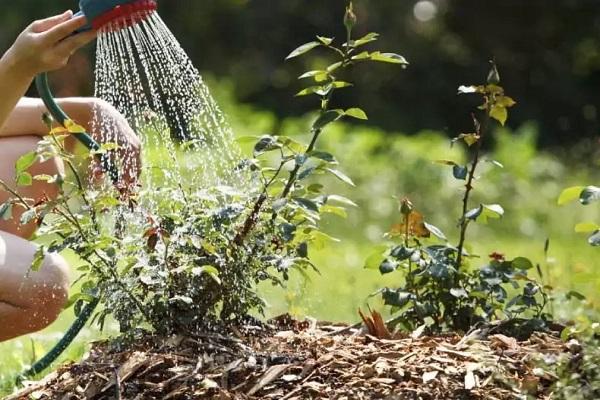
Fertilizers
For the Sahara variety, organic and mineral fertilizers are used. Organic matter is required during periods of active growth and flowering, and most often it is introduced during autumn digging of soil. Mineral dressings act purposefully, but they can saline the soil. The best option is to apply complex fertilizer 2-3 times a year.
Pruning
When pruning the bushes, the Sahara roses remove old and damaged shoots. Pruning is carried out in the spring and early fall. Timely pruning significantly reduces the risk of plant diseases.
Preparing for winter
The resistance of Sahara roses to frost allows for minimal preparation for the coming cold weather. In autumn, when the first morning frosts begin, the bushes are pruned and the old foliage is removed. Climbing shoots are inclined to the ground, placing foam or wooden boards. From above, the plantings are covered with spruce branches, and snow acts as a natural protective layer.
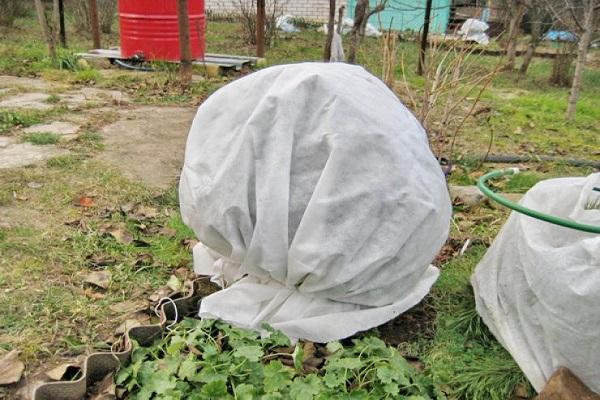
Disease and pest control
Despite the resistance of the Sahara rose variety to diseases and pests, unfavorable conditions can lead to damage to the roots and the ground part of the bushes.For recovery, fungicidal and insecticidal preparations are used, as well as folk methods - treatment with infusion of wood ash and mullein, milkweed solution, chopped pepper.
Breeding methods
The Sahara variety is most often propagated by the burrito method. For this, cuttings up to 20 cm long, more than 0.5 cm thick and with 3-4 buds are cut in the spring. Several cuttings are wrapped in a couple of layers of newspaper, moistened with water, put into polyethylene and stored in a dark place at a temperature of about 15 degrees.
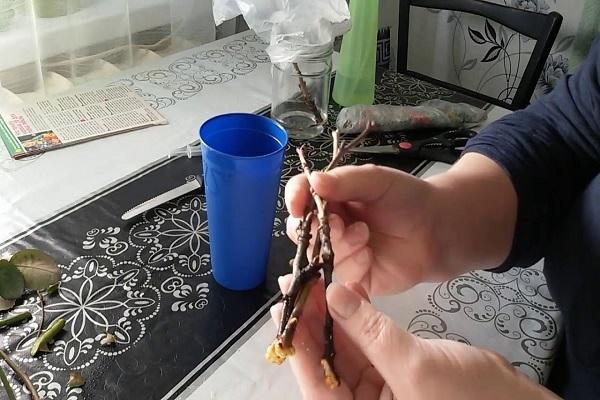
When roots are formed on the cuttings, they are planted in pots, leaving one bud above a layer of earth.
The container is covered with a film to create greenhouse conditions and periodically sprayed.
Application of the Sahara rose in garden design
When designing the site design, you can use the Sahara rose variety as part of the flower bed or as separate plantings. The original appearance allows you to competently place accents and bring bright colors to the garden area.






